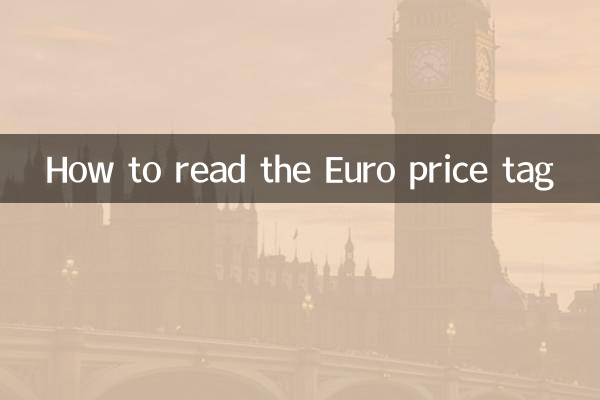How to read the Euro price tag
With the fluctuations of the global economy, changes in the euro exchange rate have become one of the hot topics recently. Whether traveling, shopping or investing, it's crucial to understand what the euro price tag means. This article will combine the hot content on the Internet in the past 10 days to analyze how to understand the euro price tag and provide structured data for reference.
1. Recent trends in the euro exchange rate

Based on recent developments in financial markets, the exchange rate of the euro against the U.S. dollar and other major currencies has been volatile. The following is the average exchange rate data of the euro against major currencies in the past 10 days:
| currency pair | average exchange rate | Fluctuation range |
|---|---|---|
| EUR/USD | 1.08 | ±0.02 |
| EUR/GBP | 0.85 | ±0.01 |
| EUR/CNY | 7.75 | ±0.15 |
| EUR/JPY | 160.50 | ±2.50 |
2. Composition of the Euro Price Label
Euro price tags usually contain the following key information:
1.Product price: A number in euros, for example €19.99.
2.tax included information: In European countries, prices usually include value-added tax (VAT), but the tax rate varies from country to country.
3.unit price: Some products will be marked with price per kilogram or per liter for easy comparison.
3. How to read Euro price tags
1.Exchange rate conversion: Use real-time exchange rate tools to convert euro prices to local currency to avoid misunderstandings caused by exchange rate fluctuations.
2.Tax calculation: Understand the value-added tax rate of the destination country. Some products may require additional taxes.
3.Price comparison skills: Pay attention to the unit price, especially for supermarket products. Different packaging specifications may affect the actual value.
4. Recent hot topics
In the past 10 days, the following hot topics related to the euro have triggered extensive discussions:
| topic | heat index | Main discussion points |
|---|---|---|
| ECB rate hike expectations | 85 | Impact on the Euro exchange rate |
| Euro consumption during peak tourist season | 78 | How to save on cross-border transaction fees |
| Eurozone inflation data | 92 | Rising prices and changes in purchasing power |
5. Practical suggestions
1.Use multi-currency payment tools: Such as Revolut or Wise, which can lock the exchange rate in real time and reduce exchange costs.
2.Follow the official exchange rate: Avoid exchanging money at the airport or hotel, where exchange rates are usually poorer.
3.Learn basic symbols: The euro symbol is €, and the number can be preceded (e.g. €10) or followed (e.g. €10), but prefixed is more common.
6. Summary
Understanding euro price tags requires a combination of exchange rates, taxes and local consumption habits. The euro has been experiencing large fluctuations recently. It is recommended to pay close attention to financial news and flexibly adjust consumption strategies. Through the structured data and practical tips provided in this article, we hope to help you make more informed decisions when shopping or investing in Europe.

check the details

check the details